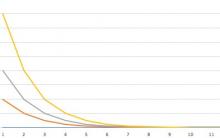How detrimental the "Amazon effect" will be for traditional retailers.
For a small group of hedge funds that bet on the fall in US real estate, financial crisis turned into a goldmine, bringing unheard of profits. Some investors believe that the next big bear will be in retail.
Americans are rapidly shifting to online shopping. Therefore, retail in the United States is going through hard times: according to Standard & Poor's, in 2017, 10 retail companies have already declared bankruptcy. Even the Sears department store chain, founded in 1886, which used to be one of the best in the country, is on the verge of collapse. .
"In our view, this downgrade could be even worse than expected," said Stephen Ketchum, head of hedge fund Sound Point Capital, which has more than $13 billion in assets. - Go to the Amazon website and type "batteries" into the search bar. What you will see is just the tip of the iceberg. And Titanic is retail.”
The steady growth of online sales poses a serious threat to American malls, developers and investors who have invested in stocks and bonds famous brands. Urban Outfitters CEO Richard Hein told analysts on a teleconference that the main problem is the huge oversupply of built retail space, coupled with the increased popularity of e-commerce.
“It created a bubble, and like real estate, that bubble burst,” Gein said. - We are now seeing the results of this: shops are closing, rental prices are falling. For the foreseeable future, the trend will continue and the rate of decline may even increase.”
All this has far-reaching consequences. Credit Suisse estimates that 8,640 stores could close in the US in 2017, with a cumulative trading area which is 13.65 million sq.m. This is more than the number of stores that closed after economic crisis and the collapse of the dot-coms. The downturn has also affected the generally healthy U.S. labor market, with an average of 9,000 layoffs per month in the retail sector this year, according to the Department of Labor, compared to an average monthly increase in retail jobs last year. 17,000.

Empty areas in shopping malls and declining department stores are just the most visible effects of what analysts have dubbed the "Amazon effect." It's about making purchases not in real commercial premises, but in a virtual space occupied by companies such as the online retail giant owned by Jeff Bezos. However, this is most likely only the first stage of a process that has begun, and some investors predict that the departure of buyers to the Internet will have a painful effect in all areas of commerce.
Byron Carlock, head of American real estate at PwC, says: “The site won't give you goosebumps - physical stores still have an advantage here. Also, I don't see consumers cutting costs, and a good retailer needs to understand that."
Yes, the process is slow right now, but if American consumers, spoiled by low interest rates and modest unemployment, fall prey to another shock, it could accelerate dramatically. For example (though unlikely), if Fed will aggressively lower rates and push the economy into recession, retail will suffer on two fronts at once: servicing loans will become more expensive, and consumers will buy less.
The impact of retail sector problems on the structure of the US labor market is likely to be serious: according to Goldman Sachs, online stores need only 0.9 employees per 1 million dollars of sales (traditional stores - 3.5 employees), so by the end of the year the industry may lose about 100 thousand jobs.

At first glance, this is not much, because in total about 16 million Americans are employed in trade, but this is only the beginning.
Medji warns: “Social and economic consequences these processes will be huge - soon we will see serious changes in the social structure.
Prepared by Evgenia Sidorova
The negative dynamics is associated with a decline in real incomes and an increase in the cost of imports.
At the end of 2016, the retail trade turnover decreased by 5.2%, reaching 28.8 trillion rubles, follows from the latest data from Rosstat. For 7.1%, it was formed from sales of retail markets and fairs, and for 92.9% - from sales of trading organizations and individual entrepreneurs doing business outside the market (in 2015 - 7.9% and 92.1%, respectively). At the same time, as in 2015, in the structure of retail trade turnover specific gravity food products(including drinks) and tobacco products amounted to 48.7%, and non-food items - 51,3%.

Reasons for the decline in retail turnover
The key reason for the decline in retail trade turnover is the decline in real incomes of the population, which continues for the third year in a row (minus 0.5% in 2014, minus 4.1% in 2015, minus 5.9% in 2016. In turn, , real incomes are declining due to the government's refusal to index pensions to inflation and the stagnation of real wages, which grew by only 0.6% last year.
Previously, the main factor in the fall in real incomes was the acceleration of inflation under the influence of devaluation, analysts of sitessia recall: in 2014-2015. the average annual dollar exchange rate rose from 38.6 to 61.1 rubles/dollar, while inflation was 11.4% and 12.9%, respectively. In 2016, inflation dropped to its lowest level in 25 years (5.4%), but this did not prevent a decline in real incomes.

Consequences of the retail downturn
The automotive market suffered the most during the crisis, analysts of the websites say: as a result of a four-year decline in sales of new passenger cars for 2013-2016 almost halved - from 2.77 to 1.43 million units (data from the Association of European Businesses). Against this background, the production of cars is also declining: in 2016, the production of passenger cars in Russia decreased by 7.4% to 1.1 million units.
Domestic automakers expect that in 2017 the automotive market will grow by 5-10%, Alexander Khalilov, co-owner of the Avtospetstsentr group, one of the five largest Russian car dealers, said in a December interview with Vedomosti. However, in his opinion, the market is waiting for a 10 percent decline.
At the same time, the crisis changed the structure of demand: sales of budget cars almost did not decrease, while sales of expensive cars (and, accordingly, profitable for dealers and manufacturers) decreased significantly. Savings among buyers has become a habit, so car dealers will earn less and less, Khalilov concluded (quote from Vedomosti).
Retail in 2017
In the coming year, the decline will affect not only domestic car dealers, but also other retail sectors, including food (in 2016, food sales decreased by 5.3% to 13.7 trillion rubles). The reason for this is the decline in real incomes, which will continue in 2017 due to the depreciation of salaries of public sector employees, website analysts believe: last July, the government approved a freeze on budget spending until 2020. It will not support retail and the conservatism of consumers, who have become more cautious during the crisis approach the purchase of durable goods.
Source: Rosstat
Retail trade statistics do not yet give rise to talk about stabilization. The rate of decline in sales of food and non-food products remains at the level of 5%. The hopes of officials for markets and fairs with allegedly cheap goods are not justified either. In this segment, the decline in sales is even faster than in large retail chains. The fall in personal consumption in 2016-2017 can only be compensated by 2020, experts say.
The pace of the monthly decline in retail trade remains one of the most worrying indicators for the Russian economy. Last July, the retail turnover was 5% less than in July last year. Since the beginning of the year, the rate of decline retail sales fluctuated in the range from minus 6.4% to minus 4.9% without obvious signs of slowing down. And for the first seven months of the year, the average reduction in retail turnover was, according to Rosstat, minus 5.6%.
This statistic takes into account the drop in sales of both food and non-food products. Moreover, the rate of decline in sales of non-food products is slightly higher - from minus 7.1% to minus 5%. Whereas sales of food products have been declining since the beginning of the year at a rate of minus 3.2% to minus 6%.
Analysts at Oxford Economics predict that the personal consumption of Russians will decrease by 5% this year, and by another 0.1% next year. In the next two years, consumption will begin to recover at a rate of 2.4% and 3.5%, respectively. Thus, the drop in consumption that will occur in 2016–2017 can only be compensated by 2020. And it will take at least two more years to compensate for the consumption losses of 2014-2015.
It is clear that with such gloomy forecasts, investments in the development of a retail network in the Russian Federation become even more risky. “The biggest decline in retail sales is observed in large cities, while regions that were more vulnerable in 2009 are now showing relative stability,” experts at Cushman & Wakefield say. “One of the reasons for this paradox is that in large cities the family budgets of the most active groups of the population are tied by mortgage payments. Therefore, even a slight decrease in income leads to a significant drop in consumption,” experts say. Retail in major cities are waiting hard times, since the volume of mortgage loans in the Russian Federation is growing and its share in total lending to the population has approached 40%, Cushman & Wakefield predicts.
Indeed, the decline, for example, in the capital's trade is more than twice the average Russian figures. In the second quarter, the capital's retail decreased by 14.9% compared to the same period last year. For comparison: in the first quarter of 2016, retail in the metropolis decreased by 11.5%, and for the whole of last year it collapsed by more than 17%.
It seems that Russian officials are unable to stop the crisis drop in the standard of living. Instead, they are making strange attempts to revive forgotten trade formats like weekend fairs or local markets where only the producers themselves should trade. " Marketplaces with minimal margins should be not only in the cities,” say representatives of the ruling party. - Our agricultural producer is very interested in selling perishable products, conditions for alternative trade should be provided in the regions; these are agricultural fairs where they could sell their products without trade margin" (cm. ).
However, hopes for markets and fairs are clearly not justified. In July, the sale of goods on retail markets and fairs on average in the country was 13.6% lower than in July last year, according to Rosstat. At the same time, the turnover of trade organizations decreased over the same period not so much - “only” by 4.3%. So, contrary to the hopes of officials, exotic forms of trade are not able to compete with industrial retail chains.
Crisis, crisis, crisis! Now we only hear about him. And since our clients are all business owners, we also hear the same thing all the time: “Sales are falling!
Clients don't have money. There are no customers either! And the main question now for everyone is how to increase sales in a crisis? How? How? Change and accelerate!
Again this crisis...
Yes, unfortunately the 90s are over, the 2000s are over. Many people want to do own business, and the market has not been as capacious as it used to be.
And during the crisis, it also decreases. Therefore, my favorite saying becomes more relevant than ever: “Now it is not the big that absorbs the small, but the fast slow”.
Hooray! Yes I am faster
And indeed it is. The sooner your company can: change the prices of goods/services.
And also change inefficient employees, find new line products, the faster you will break away from competitors or even increase your sales during a crisis.
In this article, I gave a very good example about our client, who, before the crisis, fired all the old employees and hired new ones.
In my opinion, this is not even a great example of acceleration in a crisis, but in a pre-crisis moment, which for me just compared it with the Delphic Oracle. So be sure to read it.
But enough philosophy...
Let's figure out exactly how and what needs to be done to increase sales in a crisis. Both retail and wholesale.
There are 2 proven ways to increase sales during a crisis, which are used collectively or individually:
- cut costs
- Reduce prices
If I fully agree on cost reduction, then I don't agree on dumping. Reducing the price, especially in a crisis, has not brought anyone to anything good. There are more interesting ways...
Sales increase: 8 tools
At first glance, it seems that nothing will save you in a crisis, but there is a way out. Now I will tell you about the main tools and how they can affect the increase in sales.
I warn you right away, you know these tools very well. And so, let's get started.
1. Product
First of all, you need to find another supplier with a cheaper similar product line (by the way, I recently heard on the radio that saying “product line” is wrong.
It is necessary to say “product range”, but this is so, by the way. Thus, you can capture a new niche.
A good example is a manufacturer of stretch ceilings in Irkutsk. They have always been in the segment of an expensive manufacturer.
However, before the crisis, a separate direction was singled out - cheap wholesale, with low prices, minimal guarantees and simply disgusting service (as the owner said: “So that a person clearly understands where he has come!”.
And you know, it's gone! So much so that now this direction takes up to 30% of their turnover!
Alternatively, also make a cheap-medium-expensive product if you only had an average.
Thanks to this, you will be able to expand the sales market and, perhaps, a decrease in sales in one segment will happen to you imperceptibly, thanks to an increase in sales in another.
For example, I give a picture as we showed on the website of one of our clients that he has wallpapers for every taste, starting from the cheapest (the prices, to be honest, are nowhere cheaper).
 Range
Range 2. Price
The easiest way to keep sales in a crisis is not to lower the price, but to leave it at the same level.
Just teach your salespeople/sales managers how to sell normally.
showing your competitive advantages, work out or “orally add” new qualities to it (I think the article will help you with this, it is below).
I know that this will be extremely difficult to do. After all, what is the most important weapon of a bad seller (read lazy)? Correctly! Discounts! That is why they will convince you to lower the price:
- Competitors have lower prices
- Customers demand a discount otherwise they will leave;
- We cannot sell at such high prices;
- And a million other reasons.
Important! Do not agree to this and do not follow the lead of your managers in the desire to reduce the price.
Sales during a crisis with such a strategy may increase slightly, but profits are unlikely to grow with this approach. So leave the price the same.
3. Scripts
Answer just one question. Do you have sales scripts for managers? If yes, how long ago did you update them.
You won’t believe it, but scripts for selling goods on social networks are increasingly being ordered in this direction.
Which once again confirms that only those who quickly navigate the crisis will be able to win. And another question. How long ago did you change your presentation materials?
4. Automation
Put all employees on reporting. Moreover, make them both daily and weekly (I don’t even mention monthly, a priori it should be).
Be sure to implement various automatic reminders and control over their implementation. Optimize business processes.
How? Very simple. For example, an accountant can submit all documents for a client to a manager in Bitrix 24, instead of the same Skype (one of our clients switched to such a system and is not overjoyed).
Remember, in any crisis, automation of all business processes defeats chaos.
And if you implement in your company not just CRM, but a whole one, then you will be head and shoulders above (and more successful than) 80% of small and medium business entrepreneurs.
WE ARE ALREADY MORE THAN 29,000 people.
TURN ON
5. Team spirit
There's nowhere without it. If your employees constantly talk only about the fact that the dollar / euro is growing, the crisis is getting stronger, customers are not buying anything, then, no matter how ridiculous it may be, it will be so in your company.
Therefore, motivational speeches, team spirit to win - now your main concern. To paraphrase the famous phrase, there are no bad employees in the team, there are undermotivated ones.
6. Motivation
It's time for a pay raise. And now I'm not kidding at all. Naturally, I mean all these percentages and bonuses, but not the salary part.
Give the employee the opportunity to earn more, but only if he sells. Remember, people are used to getting paid for their work, not the promise of a better life.
Do your employees already have? So that's great! Add a new bonus for a certain number of new customers or a bonus for the increase in the average check.
In addition, do not forget that employees are people too and love to be played with. Now I'm not talking in a dismissive tone, but about, for example.
The sales manager / seller who makes the biggest check in a week will go to the camp site for the weekend at the expense of the company (by the way, you can buy at Biglion without significant costs for your wallet).
Once every two or three weeks, update the reasons for the contests and the employees will get used to it and begin to fight for prizes more willingly and with pleasure.
7. Staff
The staff is more difficult. I have prepared several recommendations for raising efficiency and sales levels, even during a crisis.
Develop and train. Yes, it's time to invest in employees. Train them in sales, conduct trainings and seminars, hire and invite sales coaches.
And be sure to test on the material covered. Both in writing and orally. Otherwise, all these trainings will remain fun gatherings for your employees, and not a storehouse of useful information;
Learn to evaluate employees. Enter the employee performance criteria you want (for example, one you've never evaluated) and summarize them on a weekly or monthly basis.
Say goodbye to the inefficient. No matter how harsh it sounds, but you need to say goodbye to employees and everyone who undermines your authority in the company.
Why do you need employees in the company who only do what they complain about the crisis, the dollar, instead of selling?
Hire professionals. Now there are a lot of employees in the market. And by the way, you should not think that only bad employees are looking for work, among them there are many professionals who have lost their careers due to a closed company or layoffs. These are the ones you need to grab.
8. Leader
The most delicious - you, I left for dessert. Yes, you heard right, now we will talk about how to simplify your life.
 Hooray!
Hooray! Yes, as I wrote, there will be no easy money. You'll have to work hard. Wake up earlier, go to bed later and work harder.
Delegate all the small work to employees or outsource (for example, you can easily organize) and take care of more important things.
What will be the most important in your business is easy to understand. Just sit down for a few minutes and think about what your head is most filled with in your business. That's where you pay your attention first.
Briefly about the main
Yes, it sounds complicated, but let's do the math. If we work out each item by only 5%.
We will add new scripts to change the personnel motivation system, add CRM system and force the staff not only to occasionally enter it, but even to use it competently, then:
1.05 to the eighth = 1.48. The increase will be almost 50%!
And if each item is worked out by 10%, then the increase will be more than 100%! I answered your question how to increase sales in a crisis? 😉
And if you get a 2-fold increase in sales in your company while your competitors are dumping (and in the end, because of this, most likely they will go bankrupt), I think you can safely say to yourself that you did a great job!
There is a revival in wide retail. The consumer is stocking up on New Year's assortment on the eve of the holidays. However, this picture is not as rosy as it might seem at first glance. Prices are rising, purchasing power is falling, and it will not get better - these are the forecasts of the participants in the key link in the trade chain - distributors.
Karolina Kuznetsova, regional manager trading company"Global Trading": “Even compared to 2016, sales have declined. Of course, before the New Year, our customers try to buy goods, but they do not make such large stocks as before the crisis. Moreover, many of those who used to buy 20 tons each, today take 2-3 tons of goods, respectively, we had to stop cooperation with such customers, which became unprofitable for us. We work very low prices and at the same time we give a large volume, which means that the priority is the customer who is able to pay for the whole container.
Before the New Year, there is traditionally a growing demand for canned fruits and vegetables, fish, cereals, primarily rice. But, again, customers buy a little more product than during the year - maybe one percent.
Evgenia Dodulina, commercial director of the trading company "Prodservis": “We specialize in the meat trade - this is a product that, in principle, is always present on the consumer’s table, no matter what the year is, and for the vast majority, holidays are unthinkable without it. But I can’t talk about the New Year’s surge, which we expected and which was always present in sales during this period.”
Natalya Merzlyakova, head of the Eleon trading company: “This has never happened to us - even in the last crisis of 2008-2009. Compared to 2012-2014. Demand has doubled. If in 2012 before the holidays I could not leave work for a minute, today I have a lot of free time. And every year sales are getting weaker.”
The economy must be economical
The decline in sales is observed along the entire length of the distribution chain - from manufacturers to retail shelves, and this trend has been going on for almost four years. Experts say: the consumer continues to become poor, sales continue to fall, and accordingly, the market is being rebuilt towards the economy segment.
Karolina Kuznetsova: “The product range has changed quite a lot. The demand for the economy segment is growing during the year retail chains most of them asked for it. So, for example, one of our customers left canned saury of the middle price segment for economy. Therefore, the manufacturer also adapts to the market. Of course, Dobroflot will not produce very low-cost products under its own brand, but today some new, cheap brands are being created - for example, Neptune, that is, manufacturers bring such goods into a separate segment and every year they try to expand the line.
As the economy continues to slow down, the assortment of general retailers would become more democratic if the delivery of products was not marked by an increase in Russian Railways tariffs.
“Our products have risen in price due to the increase in Russian Railways tariffs - by about 3 rubles per kg,” notes Evgenia Dodulina.
At the same time, according to experts, the meat industry was affected by the rejection of Brazilian imports. From December 1, Rosselkhoznadzor temporarily restricted the import of pork and beef products from Brazil - the department found a prohibited growth stimulant - ractopamine in the goods. But distributors and retailers believe that this ban rests on big politics. And, as was already the case with the closure of Turkish, American import routes, someone's business tied to Brazilian products suffered. But a number of Russian manufacturers received winning positions.
2018 will be marked by austerity, experts say — even more stringent, given that the costs of logistics, utilities, etc. are growing, while the real incomes of the population are falling.
Evgenia Dodulina: “Look around and you will see that the market has already changed. Companies began to save, and to a large extent this affects personnel policy. Orientation - to more qualified personnel, and it is important that these personnel are engaged in work for 8 hours of working time. Weak companies closed down, strong ones, on the contrary, began to think about how to develop further. In the Far East, such budget chains with reduced prices as "Radius" and the Novosibirsk chain "Svetofor" appeared. Remember, before the crisis there were none.”
The market will no longer be the same, at least in 2018-2019. - exactly, experts warn, despite the promising news that "the Central Bank believed in the future of the Russian economy." And while Elvira Nibiullina says that "the economy is stable, it can and should grow faster," the consumer buys the cheapest champagne for the New Year's table, since today he has a variety of choices.
“The most budgetary champagne today can be purchased in the region of 150 rubles. Mostly sparkling wines Russian production",- He speaks Olga Shilova, Deputy General Director of ZAO Pacific Food Company.
In obese years 2012-2014. there was no such range. Today he appeared, in accordance with the Italian proverb, which in the Russian version sounds like "Roberto loved olives, and now he loves potatoes on onion sauce."
Marina Ostanina, CEO trading company "Rusimport - Primorye": “We note with regret that New Year's budgets are being cut. Corporate events are becoming more budgetary, and in many companies they are simply cancelled. In addition, it cannot be discounted that if earlier it was a widespread tradition to celebrate the holiday at home, with the family, today many of our citizens have changed their priorities and fly to warm countries, which means they take with them money that they could spend here. Compared to last year, the demand for new Year gifts, toys. The same applies to alcohol. Of course, some of the stable consumers remain, but just as a 20% drop in sales occurred 2 years ago, these figures remain approximately at the same level. People have reduced the cost of consuming alcohol.”
Julia PIVNENKO











Flower party: a bouquet of positive emotions
Words of teachers in a congratulatory scene for parents
Who's Who by Relationship Her mother-in-law calls her mother-in-law mom
Your mother is my mother-in-law Riddle mother-in-law calls my mother-in-law
How to make a scene for a wedding “Three girls under the window Comic scene three girls